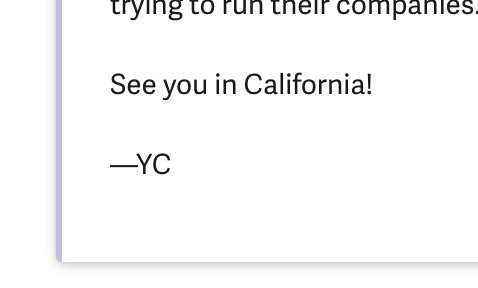However, they aggressively *rewrite* those drafts.
How to rewrite bad writing 👇
After rewriting 400,000 words on my site...
Advice for blog posts, tweets, emails:
However, they aggressively *rewrite* those drafts.
Your second draft is for identifying the best ideas then making them resonate.
The enemy of rewriting is being precious about what you originally said and how you originally said it.
You need to be willing to destroy.
Readers don't assess the quality of nonfiction by its elegance nor its complexity.
Instead, they assess:
[How strong your ideas are] x [how intuitively they understand them]
Unclear sentences distract from that understanding.
Write sentences that a thirteen-year-old could follow.
If they can understand you, so can everyone else.
That isn't to say children should understand the details.
Rather, children must be able to follow the logic of every argument.
• You use plain phrasing.
• You use fewer ideas per sentence.
Use these techniques in your writing too.
"The obstacle facing media organizations is to chart an economically sustainable course through a landscape of commodity journalism.”
“News companies are having a hard time staying in business because anyone with a blog or Twitter account can report the news now."
By removing overhead, the underlying point stands out.
The complexity of your writing should emerge from the strength of its ideas—not the wording.
The next step is rewriting for succinctness.
Remove everything you now realize is not required to make your point.
A post can be 50,000 words, but if it's dense with insights and devoid of rambling, it's succinct.
For each section of your post:
• Read all its paragraphs.
• Take an hour-long break.
• Rewrite the section from memory—focusing only on key points.
The fluff falls away when you focus on trying to effectively re-articulate your idea.
• Have them read your draft.
• Ask them to summarize it over the phone in thirty seconds.
• Delete your draft and restart from their summary.
• Add more words only as needed to make your point resonate.
The art of rewriting is the art of becoming self-aware about the purpose of every word you've written.
• Remove ideas that aren't critical to the central point.
• Don't describe what doesn't need to be described.
"To be brief on the sentence-level, remove words that don’t add necessary context. Extra words cause readers to slow down and do extra work. That makes it harder for them to recognize the sentence’s point. And when you exhaust readers, they quit reading."
"Your sentence is brief when no additional words can be removed. Being succinct is important because filler buries your talking points and bores readers into quitting."
Bingo.
Clarity and succinctness are what help ideas resonate. They reduce the friction of reading.
But it’s *intrigue* that gets people to read in the first place.
1. Novelty — A claim that's counter-intuitive, counter-narrative, surprising, or elegantly poetic.
Novelty = New info that readers would not have easily intuited on their own.
Tease readers with a question you don't answer until later.
If you weave (1) novelty and (2) withhold information, readers are likely to remain engaged.
@waitbutwhy is great at this.
• Ask feedback-givers to highlight every sentence that gives them a dopamine hit. Those are the moments of novelty: "Ahh, that's interesting."
• For each hit, increase a counter at the end of its sentence. Like this (3).
• Rinse and repeat until your article has a steady cadence of dopamine hits.
I want you to consider two psychological principles.
1. The hook principle — "A captivating intro buys goodwill with readers so they overlook an imperfect middle."
The peak-end rule — “People judge an experience largely based on how they felt at its most intense point and at its end. This implies they do not judge the experience based on the average of every moment.”
1. Have a captivating intro that buys goodwill.
2. Have at least one sustained peak of insight or surprise.
3. Have an ending that satisfyingly justifies why the piece was worth reading.
• Use simple wording and simple sentences.
• Simple language doesn't weaken ideas. It strengthens them by helping what matters stand out.
• Evenly distribute dopamine hits. Rely on feedback; it's hard to judge this yourself.
If you want more writing content, you can give me a follow and turn on notifications.
See my past threads here:
@julian
—Neil Gaiman (@neilhimself)
For specifics, see my handbook.
It's free, and I have nothing to sell you:
https://t.co/BJkEXDWUxr
More from Julian Shapiro
You May Also Like
Great article from @AsheSchow. I lived thru the 'Satanic Panic' of the 1980's/early 1990's asking myself "Has eveyrbody lost their GODDAMN MINDS?!"
The 3 big things that made the 1980's/early 1990's surreal for me.
1) Satanic Panic - satanism in the day cares ahhhh!
2) "Repressed memory" syndrome
3) Facilitated Communication [FC]
All 3 led to massive abuse.
"Therapists" -and I use the term to describe these quacks loosely - would hypnotize people & convince they they were 'reliving' past memories of Mom & Dad killing babies in Satanic rituals in the basement while they were growing up.
Other 'therapists' would badger kids until they invented stories about watching alligators eat babies dropped into a lake from a hot air balloon. Kids would deny anything happened for hours until the therapist 'broke through' and 'found' the 'truth'.
FC was a movement that started with the claim severely handicapped individuals were able to 'type' legible sentences & communicate if a 'helper' guided their hands over a keyboard.
For three years I have wanted to write an article on moral panics. I have collected anecdotes and similarities between today\u2019s moral panic and those of the past - particularly the Satanic Panic of the 80s.
— Ashe Schow (@AsheSchow) September 29, 2018
This is my finished product: https://t.co/otcM1uuUDk
The 3 big things that made the 1980's/early 1990's surreal for me.
1) Satanic Panic - satanism in the day cares ahhhh!
2) "Repressed memory" syndrome
3) Facilitated Communication [FC]
All 3 led to massive abuse.
"Therapists" -and I use the term to describe these quacks loosely - would hypnotize people & convince they they were 'reliving' past memories of Mom & Dad killing babies in Satanic rituals in the basement while they were growing up.
Other 'therapists' would badger kids until they invented stories about watching alligators eat babies dropped into a lake from a hot air balloon. Kids would deny anything happened for hours until the therapist 'broke through' and 'found' the 'truth'.
FC was a movement that started with the claim severely handicapped individuals were able to 'type' legible sentences & communicate if a 'helper' guided their hands over a keyboard.
1/ 👋 Excited to share what we’ve been building at https://t.co/GOQJ7LjQ2t + we are going to tweetstorm our progress every week!
Week 1 highlights: getting shortlisted for YC W2019🤞, acquiring a premium domain💰, meeting Substack's @hamishmckenzie and Stripe CEO @patrickc 🤩
2/ So what is Brew?
brew / bru : / to make (beer, coffee etc.) / verb: begin to develop 🌱
A place for you to enjoy premium content while supporting your favorite creators. Sort of like a ‘Consumer-facing Patreon’ cc @jackconte
(we’re still working on the pitch)
3/ So, why be so transparent? Two words: launch strategy.
jk 😅 a) I loooove doing something consistently for a long period of time b) limited downside and infinite upside (feedback, accountability, reach).
cc @altimor, @pmarca

4/ https://t.co/GOQJ7LjQ2t domain 🍻
It started with a cold email. Guess what? He was using BuyMeACoffee on his blog, and was excited to hear about what we're building next. Within 2w, we signed the deal at @Escrowcom's SF office. You’re a pleasure to work with @MichaelCyger!
5/ @ycombinator's invite for the in-person interview arrived that evening. Quite a day!
Thanks @patio11 for the thoughtful feedback on our YC application, and @gabhubert for your directions on positioning the product — set the tone for our pitch!

Week 1 highlights: getting shortlisted for YC W2019🤞, acquiring a premium domain💰, meeting Substack's @hamishmckenzie and Stripe CEO @patrickc 🤩
2/ So what is Brew?
brew / bru : / to make (beer, coffee etc.) / verb: begin to develop 🌱
A place for you to enjoy premium content while supporting your favorite creators. Sort of like a ‘Consumer-facing Patreon’ cc @jackconte
(we’re still working on the pitch)
3/ So, why be so transparent? Two words: launch strategy.
jk 😅 a) I loooove doing something consistently for a long period of time b) limited downside and infinite upside (feedback, accountability, reach).
cc @altimor, @pmarca

4/ https://t.co/GOQJ7LjQ2t domain 🍻
It started with a cold email. Guess what? He was using BuyMeACoffee on his blog, and was excited to hear about what we're building next. Within 2w, we signed the deal at @Escrowcom's SF office. You’re a pleasure to work with @MichaelCyger!
5/ @ycombinator's invite for the in-person interview arrived that evening. Quite a day!
Thanks @patio11 for the thoughtful feedback on our YC application, and @gabhubert for your directions on positioning the product — set the tone for our pitch!




















